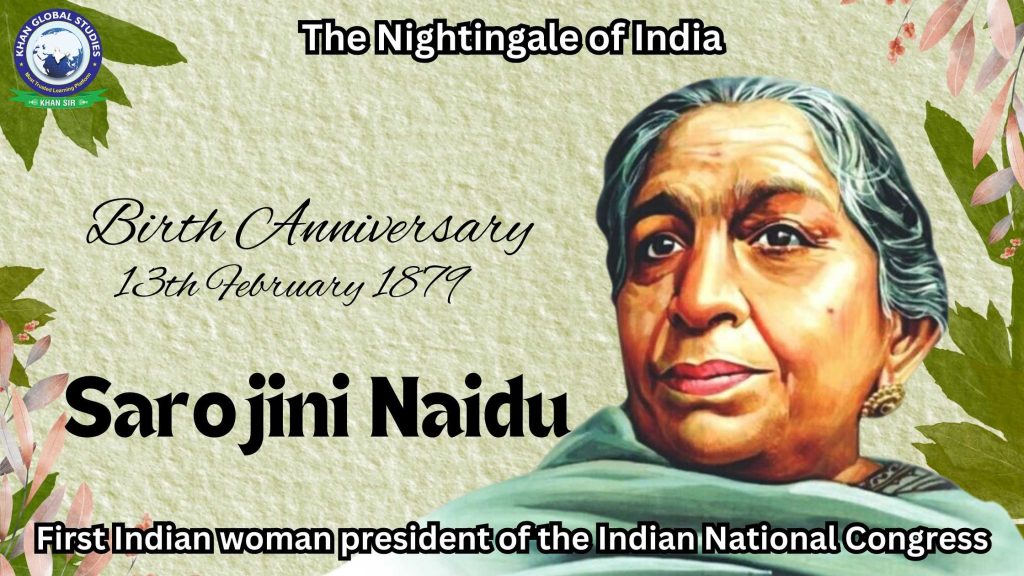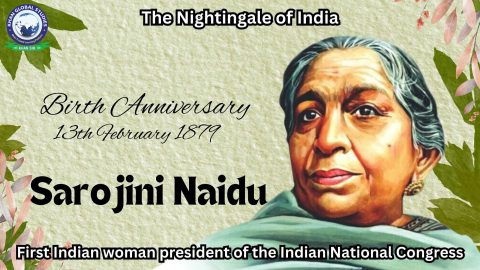Famously known as the “Nightingale of India”, Sarojini Naidu was a remarkable poet, fearless freedom fighter and influential politician. Her birth anniversary, celebrated on February 13, is a day to honour her immense contribution to India’s freedom movement, literature and women’s rights. As we approach Sarojini Naidu’s Birth Anniversary 2025, let’s learn about her life, achievements and lasting legacy.
Biography of Sarojini Naidu
| Full Name | Sarojini Chattopadhyay Naidu |
| Born | February 13, 1879, Hyderabad, India |
| Died | March 2, 1949, Lucknow, India |
| Famous As | Poet, Freedom Fighter, Politician |
| Nickname | Nightingale of India |
| Education | King’s College, London; Girton College, Cambridge |
| Political Affiliations | Indian National Congress (INC) |
| Important Role in the Freedom Movement | Non-Cooperation Movement, Civil Disobedience Movement, Quit India Movement |
| Major Political Achievements | First Indian woman president of INC (1925), First woman governor of Uttar Pradesh (1947) |
| Literary Contributions | The Golden Threshold (1905), The Bird of Time (1912), The Broken Wing (1917), The Sceptred Flute (1928), The Feather of the Dawn (1961) |
| Advocacy of Women’s Rights | Co-founder of Women’s Indian Association (1917), President of All India Women’s Conference (1930) |
| Legacy | National Women’s Day (13 February), Memorials, Literary tributes |
Early Life and Education
Born on February 13, 1879 in Hyderabad, Sarojini Naidu showed remarkable talent in writing from an early age. Her father Aghornath Chattopadhyay was a scientist and philosopher, while her mother Barada Sundari Devi was a poet.
She received her education from King’s College, London and Girton College, Cambridge. While studying abroad, she was influenced by leaders such as Gopal Krishna Gokhale and Mahatma Gandhi, which shaped her future role in India’s freedom struggle.
Role of Sarojini Naidu in India’s freedom struggle
Sarojini Naidu was not only a poet; she was a fierce freedom fighter. She actively participated in the Indian National Congress (INC) and played a vital role in India’s fight for independence.
Important Milestones in her Political Life
- First Indian woman president of INC (1925): She became the first Indian woman to preside over a session of the Indian National Congress.
- Salt March (1930): She participated in Mahatma Gandhi’s Salt March in protest against the British salt laws.
- Quit India Movement (1942): She was arrested for 21 months for her active participation in the movement against British rule.
- First woman governor of Uttar Pradesh (1947): After independence, she was appointed the first woman governor of Uttar Pradesh.
Her indomitable courage and leadership made her a symbol of resistance against British oppression.
Literary Contributions of Sarojini Naidu
Sarojini Naidu’s poetry is known for its poetic beauty and patriotic fervor. Her works brilliantly combine Indian themes with Western literary styles, making her one of India’s most famous poets.
Notable Works of Sarojini Naidu
- The Golden Threshold (1905): a collection of poems that includes palanquin bearers and Indian weavers.
- The Birds of Time (1912): shows the vibrancy of Indian markets in the bazaars of Hyderabad..
- The Broken Wing (1917): includes The Gift of India, a tribute to Indian soldiers in World War I.
- The Sceptred Flute (1928): a compilation of her early works.
- The Feather of the Dawn (1961, published posthumously): shows her poetic talent. Her poetic talent earned her the title of “Nightingale of India”.
Advocacy of Women’s Rights
Sarojini Naidu was a staunch supporter of women’s rights. She strongly believed that women’s empowerment was vital for national progress.
Significant Contributions to Women’s Rights
- Co-founder of the Women’s Indian Association (1917): Promoted education, health and legal rights for women.
- International Representation: Represented India at global conferences, advocating for women’s suffrage.
- President of the All India Women’s Conference (1930): Campaigned for women’s suffrage and legal reforms.
Her efforts laid the foundation for the women’s rights movement in India.
Role of Sarojini Naidu in Post-Independence India
After India’s independence in 1947, Sarojini Naidu continued to serve as the first woman governor of Uttar Pradesh.
Key Achievements as Governor
- Worked towards communal harmony in divided India after Partition.
- Advocated women’s legal and employment rights.
- Promoted education and social welfare initiatives.
Her contributions as a leader helped shape the newly independent nation.
Legacy of Sarojini Naidu
Sarojini Naidu’s legacy continues to inspire generations. Her contributions to freedom, literature, and women’s rights are honored in many ways.
How her legacy is celebrated?
- National Women’s Day (February 13): Celebrated to honor her achievements.
- Sarojini Naidu Award: Given for excellence in journalism on women’s issues.
- Educational Institutions: Schools and colleges named after her.
- Memorials and Literary Tributes: Her works are studied globally.
Sarojini Naidu Jayanti 2025: How to Celebrate
As we approach Sarojini Naidu Jayanti 2025, it is time to reflect on her contributions. Here are some ways to celebrate:
- Read her works: Read her poems and speeches.
- Promote women’s rights: Support initiatives that empower women.
- Educational programmes: Schools can organise programmes to teach about her legacy.
Conclusion
Sarojini Naidu was a pioneer in politics, literature and women’s rights. Her birth anniversary is a reminder of her courage and vision. As we celebrate Sarojini Naidu Jayanti 2025, let us strive to carry forward her ideals of equality, empowerment and patriotism.





